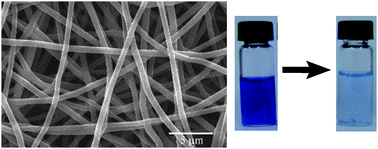We report the fabrication of water-stable electrospun polyethyleneimine (PEI)/polyvinyl alcohol (PVA) nanofibers that have super dye sorption capability. Electrospinning parameters including flow rate, applied voltage, and polymer concentration were optimized to obtain smooth and uniform PEI/PVA nanofibers. The nanofibers with a mean diameter of 490 ± 83 nm can be rendered water insoluble via crosslinking using glutaraldehyde vapor. The formed nanofibers with a smooth and uniform morphology before and after crosslinking were characterized using scanning electron microscopy, Fourier transform infrared spectroscopy, and mechanical property testing. The sorption capability of the PEI/PVA nanofibers was confirmed by UV-vis spectrometry. We show that the water-stable nanofibrous mats can effectively absorb methyl blue, which is a typical dye used in the printing and dyeing industry. The dye sorption kinetics and isotherm follow the pseudo-second-order model and the Langmuir model, respectively. The developed polymer nanofiber system has a great potential in decolorizing dyeing wastewater for environmental remediation applications.

You have access to this article
 Please wait while we load your content...
Something went wrong. Try again?
Please wait while we load your content...
Something went wrong. Try again?


 Please wait while we load your content...
Please wait while we load your content...